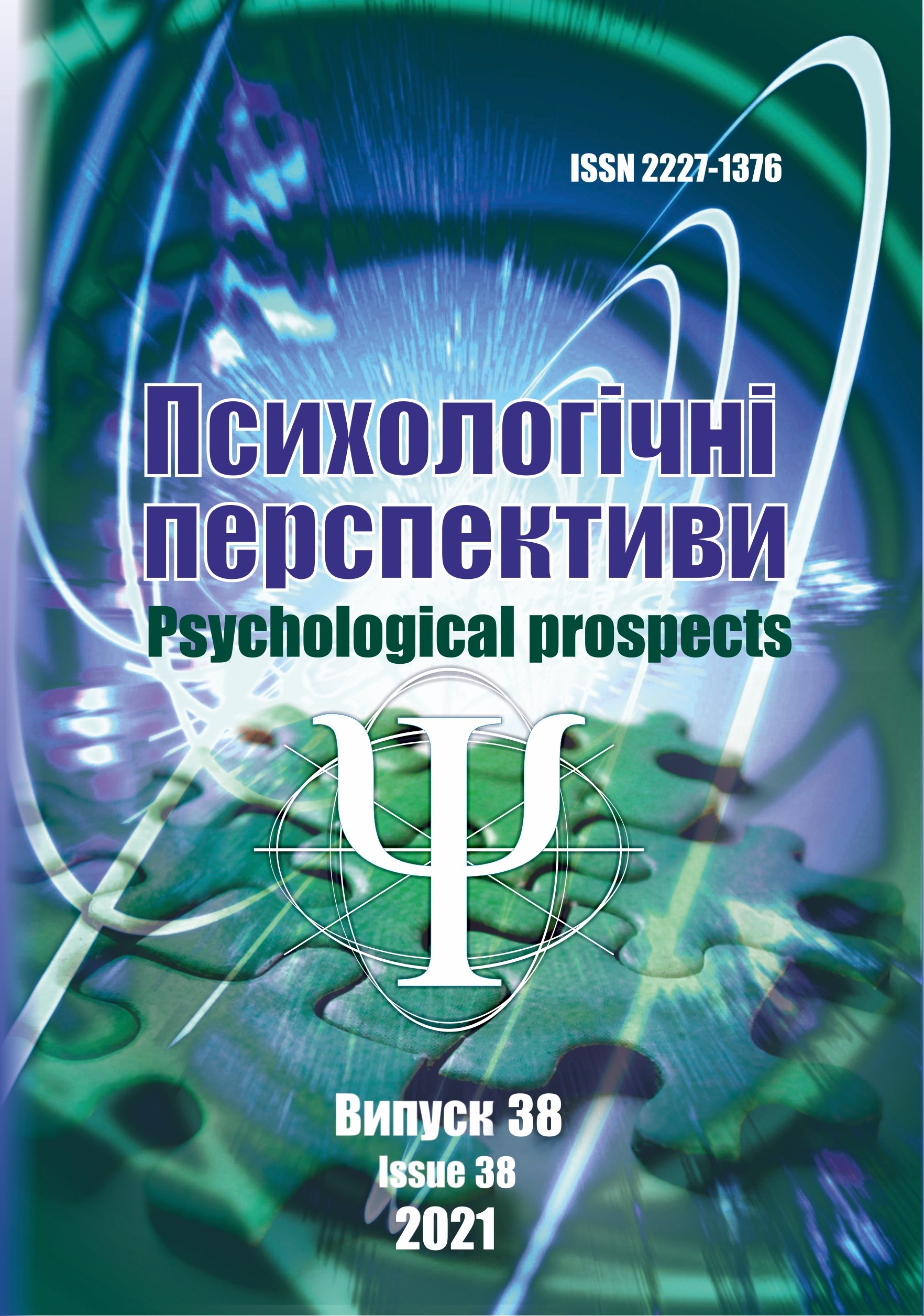Psychological peculiarities of spatio-temporal deprivation and stigmatization of personality
DOI:
https://doi.org/10.29038/2227-1376-2021-38-10-21Keywords:
deprivation, spatio-temporal deprivation, deprived chronotype, housing deprivation, closed educational institutions, marginality, stigmatization of personality.Abstract
Purpose. The article provides a theoretical analysis of the psychological peculiarities of spatio-temporal deprivation (deprived chronotype) and stigmatization of personality. Methods. The methods of scientific theoretical analysis were used for the realization of the research’s purpose: analysis, synthesis, abstract method, generalization. Results. Scientific psychological analysis of the source base has led to the assertion that the problem of spatio-temporal restrictions correlates closely with its stigmatization. The mode of various restrictions blocks a person’s vital activity, and stiffness and oversaturation (as well as deprivation) of personal space bring chaos and ambivalence to the awareness of lifetime. The spatial deprivation complicates and slows down the construction of adequate images of self-identity and harmonious self-construction, as well as blocks personal potential and suppresses individual optimism and the legend of the life path. The deprived person has several problems with personal adaptation, and being in the early stages of ontogenesis and sociogenesis in closed-type educational institutions determines a pessimistic mode of self-awareness. The spatio-temporal deprivation creates an imbalance of a person’s mental world, causes psycho-emotional burnout, and development of excessive anxiety, frustration, and other mental states. It cultivates a child's suppression and marginality and imposes a certain stigma, which is overcome with varying degrees of success throughout life. Orphans and children living in boarding institutions quite often polarise the world according to the parameter 'friend or foe' and may experience social exclusion and several other limitations to their psycho-social development. Conclusions. Blocking of spatio-temporal dimensions of the deprived person is a significant psycho-traumatic factor and affects negatively their mental structure, in particular the sensory-emotional, cognitive, and value-behavioral components. Deprivation stigma can cause antisocial and/or deviant personality behavior, therefore, professional revitalization support containing preventive, consultative and corrective, and developmental measures is needed.References
Bankovskaya, S.P. (2002). Chuzhaki i granitsyi: k ponyatiyu sotsialnoy marginalnosti [Strangers and Borders: Towards the Concept of Social Marginality]. Otechestvennyie zapiski - Domestic Notes, 6, 457-467 [in Russian].
Bahmatova, T.G., Chusova, Yu.A. (2015). Sotsialnaya eksklyuziya sirot kak determinant kriminogennogo povedeniya [Social exclusion of orphans as a determinant of criminal behavior.]. Kriminologicheskiy zhurnal Baykalskogo gosudarstvennogo universiteta ekonomiki i prava - Criminological Journal of the Baikal State University of Economics and Law, 9 (4), 674-681 [in Russian].
Butovskaya, M.L., Dyakonov, I. Yu. (2003). Psihologicheskie osobennosti i emotsionalno-tsennostnaya sfera u nischihyu [Psychological characteristics and emotional-value sphere of the beggar]. Voprosyi psihologii - Psychology Questions, 3, 83-92 [in Russian].
Hoshovskyi, Ya. (2010). Depryvovanyi khronotop yak nehatyvnyi chynnyk samorealizatsii osobystosti [Deprived chronotope as a negative factor of self-realization of personality]. Osvita rehionu - Education of the region, 1, 123-127 [in Ukrainian].
Hoshovskyi, Ya., Hoshovska, D. (2016). Fenomen emotsiinoho vyhorannia osobystosti u konteksti depryvovanoi psykhohenezy [The Emotional Burnout of a Personality in the Context of Deprived Psychogenesis]. Psykholohichni perspektyvy - Psychological Prospects Journal, 28, 67-80. DOI: https://doi.org/10.29038/2227-1376-2016-28-70-82 [in Ukrainian].
Kazakova, A.Yu. (2017). Territorialnaya stigma kak istochnik zhilischnoy deprivatsii [Territorial stigma as a source of housing deprivation]. Kirov: Izd-vo MTsITO [in Russian].
Nartova-Bochaver, S.K. (2003). Ponyatie „psihologicheskoe prostranstvo lichnosti”: obosnovanie i prikladnoe znachenie [The concept of "psychological space of personality": justification and applied meaning]. Psihologicheskiy zhurnal - Psychological journal, 24 (6), 27–36 [in Russian].
Shutilina (Korneva), A.A., Terre, K. V., Sagalakova, O.A. (2015). Formirovanie sensornoy i dvigatelnoy deprivatsii u vospitannikov detskih domov kak predposyilka antivitalnogo povedeniya [Formation of sensory and motor deprivation in children from orphanages as a prerequisite for anti-vital behavior]. Novaya nauka: opyit, traditsii, innovatsii - New Science: Experience, Tradition, Innovation, 4-2, 66-68 [in Russian].
Yaraya, T.A. (2014). Stigmatizatsiya kak mehanizm formirovaniya proyavleniy gandikapa [Stigma as a mechanism for the formation of manifestations of handicap]. Problemyi sovremennogo pedagogicheskogo obrazovaniya - Problems of modern teacher education, 44-1, 327-333 [in Russian].
Аyala, L., Navarro, C. (2007). The dynamics of housing deprivation. Journal of Housing Economics, 16, 72–97.
Bowlby, J. (1961). Child Care and Growth of Love. N.Y.: Penguin Book.
Chan, N. (2001) Stigma and its Assessment Methods, Pacific Rim Property Research Journal, 7:2, 126-140, DOI: https://doi.org/10.1080/14445921.2001.11104100
Nashashibi, R. (2007). Ghetto cosmopolitanism. Making theory at the margins. Deciphering the Global: its Spaces, Scales, and Subjects / Ed. by S. Sassen. (рр. 243-264). London and New York: Routledge.
Downloads
Published
Issue
Section
License
Copyright (c) 2021 Psychological Prospects Journal

This work is licensed under a Creative Commons Attribution-NonCommercial 4.0 International License.










